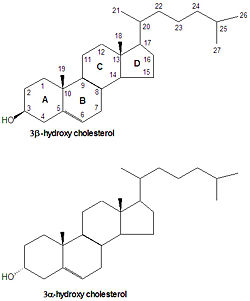Cholesterol: Difference between revisions
imported>Robert Badgett |
imported>Caesar Schinas m (Bot: Update image code) |
||
| Line 1: | Line 1: | ||
{{subpages}} | {{subpages}} | ||
{{Image|Cholesterol structure nomenclature DEVolk.jpg|right|250px|Structure and nomenclature of cholesterol. All steroid nomenclature is based on cholesterol. By convention, substituents pointing up, like C-18 and C-19, are called <math>\beta</math> while those pointing down are called <math>\alpha</math>.}} | |||
'''Cholesterol''' is a [[lipid]] that is the "principal sterol of all higher animals, distributed in body tissues, especially the brain and spinal cord, and in animal fats and oils."<ref>{{MeSH}}</ref> | '''Cholesterol''' is a [[lipid]] that is the "principal sterol of all higher animals, distributed in body tissues, especially the brain and spinal cord, and in animal fats and oils."<ref>{{MeSH}}</ref> | ||
Revision as of 05:33, 8 June 2009
Cholesterol is a lipid that is the "principal sterol of all higher animals, distributed in body tissues, especially the brain and spinal cord, and in animal fats and oils."[1]
There is much confusion, in the lay press, between cholesterol itself, and the lipoproteins that carry it in the blood. References to "bad cholesterol" are misleading because cholesterol is cholesterol, but low-density lipoproteins (LDL) tend to increase atherosclerosis while high-density lipoproteins (HDL) tend to decrease it.
Disorders of cholesterol
Hypercholesterolemia may contribute to coronary heart disease, stroke, and other complications.
Hypoalphalipoproteinemia is abnormally low levels of alpha-lipoproteins (high-density lipoproteins or HDL) in the blood. Low levels of high-density lipoproteins in the blood is a component of the metabolic syndrome.
Treatment
Hypercholesterolemia may be treated by antilipemic agents such as hydroxymethylglutaryl-coenzyme A reductase inhibitors (statins), bile acid sequestrants, fibric acid derivatives, and plant stanols. The effect is less on cholesterol itself than on decreasing LDL or raising HDL.
References
- ↑ Anonymous (2024), Cholesterol (English). Medical Subject Headings. U.S. National Library of Medicine.


